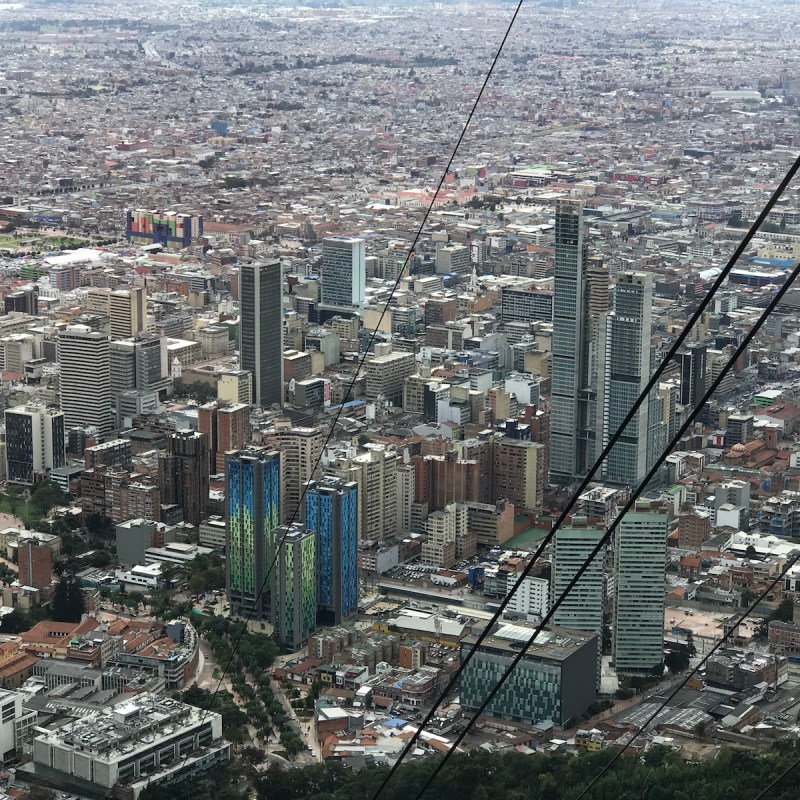
With a personality marked by its culture, art, and Colonial heritage, Bogotá is a city of nonstop energy and color. The third-highest capital city in the world in altitude, Bogotá is also a city with traffic snarls, crowds, and the attenuating issues that come with urban life. But, overall, it’s a city that will entice you to visit again and again.
Videos by TravelAwaits
As a resident of New York City, I’m no stranger to urban chaos, but I’m also adept at searching out spaces that offer serenity. Bogotá offers a combination of energy levels, but be prepared if you suffer from altitude sickness — Bogotá is perched at 8,661 feet above sea level.
Join me as I share my favorite ways to experience this beautiful Colombian city through places to visit, traditions to explore, and sights to see.

Art And History
Bogotá is rich in cultural offerings. Bring your sunglasses — colorful is an understatement for this city. Three of its indoor museums are especially fascinating while the streets offer an outdoor art gallery bar none.
1. Museo Del Oro
Most visitors to Bogotá make a beeline to the Museo del Oro in La Candelaria, the city’s Colonial quarter. The museum houses an impressive collection of gold artifacts, jewelry, and carvings dating back to Colombia’s wealthy pre-Colonial times. The star attraction is the dazzling golden raft, believed to be part of the mythical gold-rich city of El Dorado.
Pro Tip: If you’re short on time, there’s a small Museo del Oro art and jewelry exhibit at the Bogotá airport.
2. Museo Botero
Also in La Candelaria, the Museo Botero features the buxom, larger-than-life sculptures of Colombian artist Fernando Botero. Stipulated by Botero to be free to everyone, the museum also showcases a collection of his paintings. Pause at the entrance for a photo near the oversized sculpture of a hand, then head to the adjacent rooms that rim the Colonial building.

3. Musa Bogotá
The city’s archeological museum, musa, is set in the 17th-century Casa del Marqués de San Jorge, now home to an extensive collection of pre-Columbian ceramics. The building itself is a fine example of a preserved Colonial house with an outdoor courtyard.
4. La Candelaria Street Art
Graffiti and street art appear everywhere in Bogotá, but the La Candelaria historic quarter is the most well-known for its concentration of vibrant murals and thought-provoking messages. Both sides of the neighborhood’s pedestrian-only streets are painted with topical oeuvres ranging from political statements to commentaries on life in general. As you wander about, you’ll also see artisans in galleries or outside at tables that seem to blend with the surrounding street art. Look through gates and up on the roofs to find treasures that are equally surprising.
Pro Tips: It’s especially crowded by the student-filled Plaza Chorro de Quevedo and the cobblestoned side streets can be a mecca for pick-pockets. I recommend signing up for the Bogotá Graffiti Tour. The guide will safely lead you on a 2.5-hour walk offering insight into the city’s political and social issues while explaining the differences between vandalism and art.

Dining
Bogotá’s coffee culture, street food, traditional dishes, and higher-end restaurants give you a variety of choices to keep you energized.
5. La Puerta De La Catedral
An 18th-century building formerly used as a women’s college and seat of the archbishop is the location of the two-level La Puerta de la Catedral restaurant where you can sample traditional Colombian dishes. Arepas, tamales, and the combination-plate bandeja paisa are highlights on a humongous menu demonstrating the country’s Caribbean and Latin influences. Be sure to try ajiaco — Bogotá’s signature shredded chicken soup dressed up with potatoes, avocado, capers, corn, and cream.

6. Andrés D.C.
A mix of a nightclub, bachelor party, and steakhouse, the Andrés D.C. Zona T location is loud, large, and fun. Be prepared for an unforgettable experience that’s anything but calm. There’s live music, dancing, and a steady buzz. Servers and troubadours provide ongoing entertainment as well. Order chicharrones (“pork rinds”) or empanadas as starters and enjoy a steak and a bottle of wine. The labyrinth of rooms sprawls over four floors cheekily named Infierno, Tierra, Purgatorio, and Cielo.
7. Ants And Arepas
Yes, ants. More about texture than taste, these protein-rich insects (hormigas) are sold crispy from pushcarts and roving street vendors. If big-butted ants aren’t your thing, opt for a cheese-filled arepa pastry made from ground corn. At the minimum, take a photo of each.
8. Restaurante Leo
Zona G’s high-end Restaurante Leo is all about connecting with the bounty of the country. Sourcing ingredients from the rainforest to the desert, Chef Leonor Espinosa creates eccentric tasting menus of small plates that comingle “biocultural” tastes of the campo with textures of the ciudad. In contrast to simple ajiaco or arepas, Leo is Colombian gastronomy. However, one of Espinosa’s favorite dishes — seared albacore tuna with long pepper and molasses — does incorporate ants, using them as a crust.
9. El Aquelarre
The theme of this multi-room restaurant is magic mixed with witchcraft (brujeria). The menu is a voyage to another world featuring fusion dishes from different regions of Colombia. Try unique creations like karma de chicharrones or costa magica, a fantastical preparation of ceviche. El Aquelarre also recalls bruja-related events, like the Salem witch trials, on their creative drink menu. There’s also live music on weekends.

10. Coffee And Chicha
Taking advantage of the country’s pre-eminence in coffee growing, Bogotá tempts with many fragrant java bars. In La Candelaria, you’ll find fair-trade coffee used in lattes at the Cacao & Coffee House as well as tinto — the traditional black coffee served in Colombia. Santa Maria Café offers 60 versions of coffee drinks and another favorite, chicha, an alcoholic beverage made from corn. For a full chicha tasting, visit La Chicheria at Mercado La Concordia.
Views
Bogotá is a city to be viewed on high as well as at ground level.
11. Monserrate
For a striking elevated view of the city, take the funicular to the peak of Cerro de Monserrate. Dress warmly and prepare yourself for a crush of tourists ascending 10,000 feet. You’ll note the energetic climbers below, but it’s best to secure your space indoors and save your energy for a walk around the top of the mountain, where a beautiful church and the city panorama await.
Pro Tip: Weather conditions can cancel rides to the top of the mountain. Be sure to check before you go.

12. La Ruta De La Esperanza
Taking cues from Medellin’s Comuna 13 reinterpretation project, La Ruta de la Esperanza takes you to Ciudad Bolívar in the uplands of southern Bogotá. Following the “Route of Hope,” you’ll see the remarkable “in-progress” transformation of three neighborhoods through art, education, and transportation alternatives. Visitors board an ultra-modern TransMiCable car to a small museum at the Mirador del Paraiso station, where the project is explained. Then, it’s up to you to explore the area and its evocative murals, painted homes, shops, and multiple viewpoints.
Pro Tip: Show your support of the community by dining in one of the small, family-run restaurants like Pescaderia WaWanco Chocoano.
13. Santuario Nacional De Nuestra Señora Del Carmen
While not a view per se, the National Shrine of Our Lady of Carmen is worth a visit to admire its candy-cane-striped exterior and interior. The Florentine Gothic design is stunning.

Lodging
Bogotá’s range of accommodations reflects the diversity of its population and visitors. While some prefer luxury, others prefer authenticity. Here are two of my favorites illustrating those options.
14. Four Seasons Hotel Casa Medina Bogotá
The five-star Four Seasons Hotel Casa Medina Bogotá prides itself on offering impeccable service. In a prime location near the Zona G and walkable to shopping as well, the hotel combines French and Spanish architectural influences and incorporates the remnants of a Colonial convent. Rooms are modern and the beautiful Castañyoles restaurant serves all-day dining in a greenhouse setting.
15. Hotel De La Opera
With a history including a window escape by Simón Bolívar (he was chased by political enemies), this charming boutique hotel sits in the middle of La Candelaria. It’s located next to Teatro Colón and a few blocks from Bogotá’s museums, markets, and the architecture-and-pigeon-rich Plaza de Bolívar. Hotel de la Opera occupies two interconnected buildings, one furnished in Colonial style and the other having a more modern ambiance. The hotel includes a spa, the La Scala restaurant for breakfast, El Mirador for lunch and dinner, and a cozy bar for a late-night refresher.

